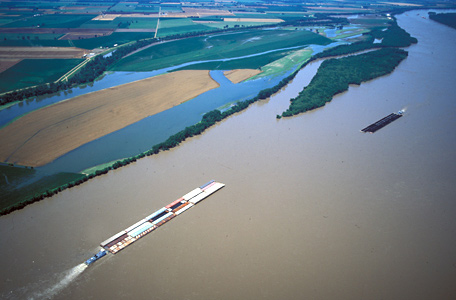The towboat at lower left is pushing 24 barges up the main channel of the Mississippi. The one at right of center guides 20 coal barges downstream. The mouth of the Ohio River is out of the picture at lower right. This photo was taken in the month of May, when spring runoff typically floods the primary floodplain, soaking the roots of farmers’ crops. The bluish color of the standing floodwater indicates that, being without a current, it has dropped its load of silt, which will serve to raise the ground level between the thin line of trees and the levee at the thick line of trees, at least until the next 100-year flood rearranges the river and its greater environs.
“Arrived oposite three new habitation of some Americans who had settled under the spanish government,” wrote Lewis on 22 November 1803. “This settlement is on a bottom called, Tywappety.”
Major Amos Stoddard described the area in 1812:
Tiwappaty bottom . . . is equal in fertility to any part of the western country. It produces a thick growth of timber, and many of the trees are of an extraordinary size. Part of this bottom, which is about twenty miles long, and from three to six miles broad, produces an immense quantity of rushes. These grow to the height of about eight feet; they are large, and stand so thick, that it is difficult for a man to make his way among them. Large droves of cattle resort to them in winter, and fatten on them.[1]Major Amos Stoddard (1772-1813), Sketches, Historical and Descriptive of Louisiana (Philadelphia: Mathew Carey, 1812), 208-09. Stoddard served in the American Revolution, then studied law and was … Continue reading
From the mouth of the Mississippi River, in 1683, Robert Cavelier, sieur de La Salle (1643-1687), claimed in the name of King Louis of France all the land it drained, and called it Louisiana. More than a century later, in 1762, France ceded Louisiana to Spain. Napoleon regained nominal ownership in 1800, but under the secret Treaty of San Ildefonso, Spain retained legal control of the huge and still largely unexplored and unmapped territory.
In 1790 some Spanish families established a village called Zewapeta, a name of uncertain meaning, on the west bank of the Mississippi above the mouth of the Ohio. Seven years later, enticed by generous Spanish land grants, some American farmers from east of the Mississippi moved in, quickly Anglicizing the Spanish name to the lilting, euphonious Tywappity, which has long since been absent from updated maps.
The social complexion of this eastern fringe of Louisiana Territory was richly varied in 1803. The next day at Cape Girardeau, thirty miles up the Mississippi, the captains found what they perceived as unsavory characters, a population “almost entirely emegrant from the frontiers of Kentuckey & Tennessee . . . [who] are the most dessolute and abandoned even among these people; they are men of desperate fortunes, [with] but little to lose, either character or property.” However, a nearby settlement of German-Swiss immigrants from North Carolina struck Lewis as “temperate, laborious and honest people.”
The latter may have been the people that Henry Marie Brackenridge described in 1811: “There is . . . a large settlement of Germans, about thirty miles west of the town. They live well, and are becoming easy in their curcumstances: there are also a number of good farms in Tywapety bottom. In general, the settlements are much scattered in this district.”[2]Henry Marie Brackenridge, Views of Louisiana, Together with a Journal of a Voyage up the Missouri River, in 1811 (1814; reprint, Chicago: Quadrangle Books, 1962), 114.
On that late-November day Lewis and his party “overtook two keels from Lousville bound to Kaskaskias loaded with dry goods and whiskey,” and “met two Keeled boats loaded with f[u]rs for New-Orleans.” Comparatively speaking, the Mississippi was probably as busy commercially in 1803 as it is today, but any one of the dozens of flat-bottomed barges being nudged up and down the river in this springtime photo-moment holds more tonnage than all those little keelboats put together.
Notes
| ↑1 | Major Amos Stoddard (1772-1813), Sketches, Historical and Descriptive of Louisiana (Philadelphia: Mathew Carey, 1812), 208-09. Stoddard served in the American Revolution, then studied law and was admitted to the Massachusetts Bar. He rejoined the army as a captain of artillery, and was promoted to the rank of major in 1807. French authorities in New Orleans deputized then-captain Stoddard to accept upper Louisiana Territory from Spain in behalf of France on March 9, 1804. On the tenth, in behalf of the United States, he formally accepted the territory from France. He served as governor and military commander of upper Louisiana for a few months, until the civil government was established. Promoted to the rank of major in 1807, he served in the War of 1812, was wounded during the British siege of Fort Meigs, Ohio, and died of tetanus a few days later, on May 11, 1813. |
|---|---|
| ↑2 | Henry Marie Brackenridge, Views of Louisiana, Together with a Journal of a Voyage up the Missouri River, in 1811 (1814; reprint, Chicago: Quadrangle Books, 1962), 114. |
Experience the Lewis and Clark Trail
The Lewis and Clark Trail Experience—our sister site at lewisandclark.travel—connects the world to people and places on the Lewis and Clark Trail.
Discover More
- The Lewis and Clark Expedition: Day by Day by Gary E. Moulton (University of Nebraska Press, 2018). The story in prose, 14 May 1804–23 September 1806.
- The Lewis and Clark Journals: An American Epic of Discovery (abridged) by Gary E. Moulton (University of Nebraska Press, 2003). Selected journal excerpts, 14 May 1804–23 September 1806.
- The Lewis and Clark Journals. by Gary E. Moulton (University of Nebraska Press, 1983–2001). The complete story in 13 volumes.


